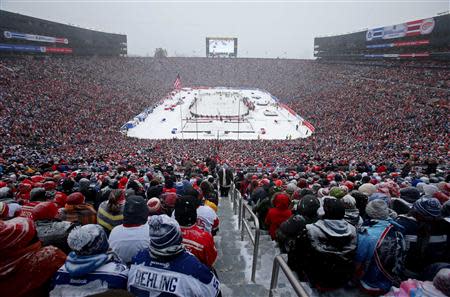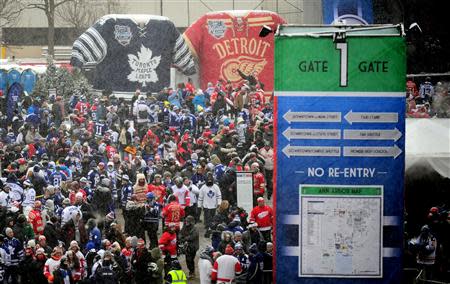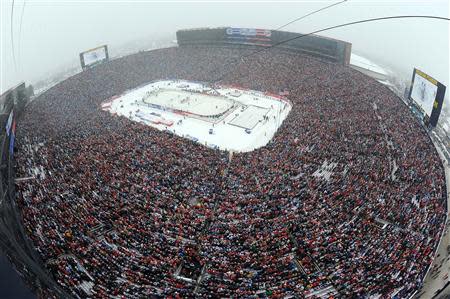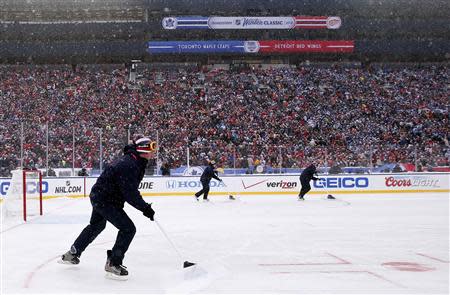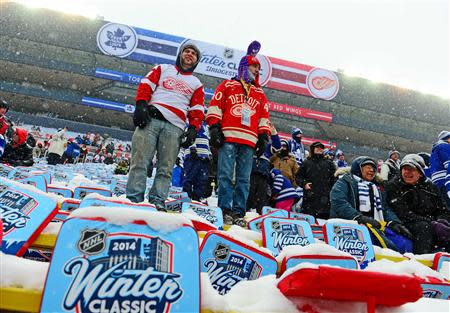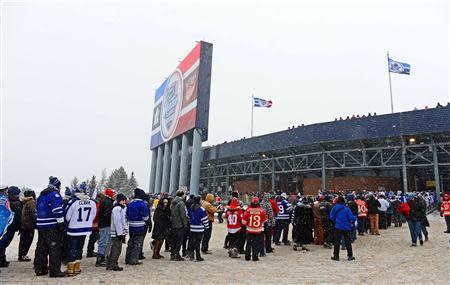Winter Classic first salvo in NHL 'shock-and-awe' campaign
By Steve Keating ANN ARBOR, Michigan (Reuters) - The National Hockey kicked of 2014 with the biggest hockey bash ever on Wednesday, firing the opening salvo in a 'shock-and-awe' campaign designed to turn casual fans into avid ones. An announced record hockey crowd of 105,491 braved brutal conditions to fill massive Michigan Stadium for the NHL's outdoor Winter Classic as the Toronto Maple Leafs clinched a 3-2 shootout win over the Detroit Red Wings. Over the next three months the NHL will play outdoor games from Los Angeles to New York featuring iconic franchises in historic settings in an unprecedented push to claim more ground in an escalating battle for a larger slice of the North American sporting landscape. Emboldened by a new 12-year $5.2 billion Canadian television rights deal, labor peace and increasing talk of expansion, a bullish NHL commissioner Gary Bettman has embarked on what one sport marketing expert described as a campaign of "shock-and-awe". Putting the Winter Classic in 'the Big House' provided the "wow" factor the NHL was looking for to kickoff the New Year but it marked just the start of the league's marketing blitz. The Winter Classic will be followed by two games at Yankee Stadium later this month and another in Los Angeles before the NHL returns to the world's biggest sporting stage at the Sochi Olympics. Coming out of Russia the NHL will try to stay in the spotlight with outdoor contests in Vancouver and Chicago that the league hopes will add to the marketing momentum heading into the Stanley Cup playoffs. "I hate to use military terms but this really is a sort of shock-and-awe campaign," Paul Swangard, managing director, Warsaw Sports Marketing Center at the University of Oregon told Reuters. "We are going to have these incredible interesting outdoor experiences with a lot of interesting story lines, we are sending them to Sochi and all those athletes are going to come back and the casual fan gets exposed." SIGNATURE EVENT In just six years the outdoor game that started as nothing more than a one-off novelty has grown into the league's marketing centre piece, a New Year's Day showcase that has eclipsed the Stanley Cup as the NHL's signature event. A concept that has captured the imagination of casual hockey fans, the appeal of the Winter Classic lies in game's outdoor roots, anchored by romantic nostalgia and wintry charm. The New Year's Day Classic, however, has grown well beyond its initial sentimental appeal into big business, a cash cow for the league, teams and the city's who have hosted them. The Winter Classic was the main event in the week long hockey extravaganza that featured alumni games, junior and minor league hockey games played in Detroit at Comerica Park, home of Major League Baseball's Tigers, pouring an estimated $60 million into the bankrupt city's economy and another $15 million into Ann Arbor. Four of the five most-watched NHL regular-season games in the U.S. since 1975 have been Winter Classics and Wednesday's edition is almost certain to join that list. "I think the week the NHL has put together here and at Comerica Park to sell our game is a great thing," said Red Wings coach Mike Babcock. "It's kind of like the Super Bowl setup in a way. "This is an unbelievable event to sell hockey." KEEPING IT SPECIAL The biggest challenge facing the NHL going forward is what to do for an encore while maintaining the uniqueness that has been part of its tremendous success. Once coy about whether there would even be regular outdoor game, the league is no longer shy about its plans, having already confirmed next year's Classic for Washington. "They've been fun and successful and for the NHL to inject some fun into the sport and take it to a wider group of fans is almost priceless," Robert Boland, chair of sports management at New York University's Tisch Center told Reuters. "To some degree the Winter Classic games are ways to move fans from the more casual to more avid. "The more you hold the less significant these events are and there is always a fine line that has to be walked. "The NHL does have to make sure that these events have an exclusivity about them." With the staging of each outdoor game the NHL has raised the bar. The first was played in 2008 in Buffalo in a Christmas card setting with the Pittsburgh Penguins' Sidney Crosby netting the overtime winner as a steady snow fell, covering the sold-out crowd at Ralph Wilson Stadium with a white frosting. The next two editions melded baseball and hockey tradition with the NHL staging the extravaganza in two of America's most iconic sporting shrines, Chicago's Wrigley Field and Boston's Fenway Park. The NHL's two biggest names, Crosby and the Washington Capitals' Alexander Ovechkin, faced off in 2011 while the New York Rangers and Philadelphia Flyers took their rivalry outdoors in 2012. NHL chief operating officer John Collins, the mastermind and driving force behind the outdoor explosion, made it clear the Winter Classic is now a league fixture but was non-committal on the number of outdoor games that would be played each season in the future. "I suspect the fact that this is all happening in the Olympic year is some reasoning behind the strategy that they are employing," said Swangard. "I would be concerned if the six-pack model would be the every-year reality of a game that I think carries some uniqueness by its scarcity. "The core fan base does need to expand, it is becoming increasingly competitive in the market place in a lot of NHL cities and these non-traditional ways that you can expose someone to the sport is a key part of the acquisition strategy. "There is obviously going to be a real fine line there." (Editing by Gene Cherry)
